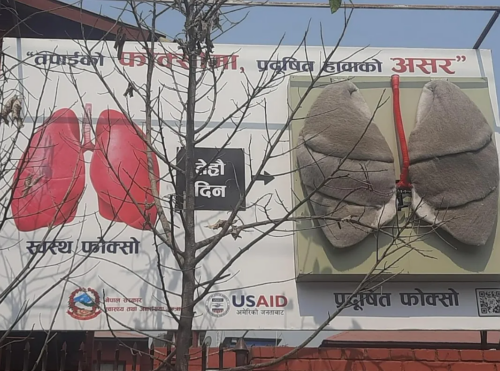How USAID Nepal Used Artificial Lungs to Show the Effects of Air Pollution on Human Health

Raising awareness about air pollution with art installations
The effects of climate change and environmental issues can oftentimes be difficult to see in our daily lives. One example is air pollution, which is a huge concern for our environmental and human health — yet, it is oftentimes difficult to see the health impacts of poor air quality.
More than six million people die each year from breathing in polluted air, making air pollution the fourth greatest risk factor for early death globally.
Over 90% of pollution-related deaths occur in low- and middle-income countries. And in countries at every income level, disease caused by air pollution is most prevalent among minorities and marginalized populations.
Climate and environmental enthusiasts across the world have used various tactics to support the adoption of improved behaviors related to health and environment, from public service announcements and policy change to taxes and bans.
However, this disconnect between an absence of visible impact and the actual reality of the state of our natural environment can be a barrier to encouraging people to take action. That’s one of the reasons why USAID is adding visual art to that list of behavior change tactics to raise awareness about the harmful effects of air pollution in Nepal.
USAID, in partnership with the Nepal Ministry of Health and Population, created a Clean Air art installation last month in which 3D artificial fabric lungs constructed with white High Efficiency Particulate Air (HEPA) filters were installed outside of the Ministry in Kathmandu to show the public how quickly the lungs get dirty in ambient air. The installation had an internal mechanism that allowed it to “breathe” by sucking in air and replicating the motions of a breathing pair of lungs.
In just two weeks, the artificial lungs turned completely black.
The blackened artificial lungs represent how seriously air pollution can impact human health. Art installations like these can be the connecting fiber between the data driven-facts about climate change and the emotions we need to feel to actually take action.
Thousands of people walked by the installation on a daily basis. Educating the public and policymakers is doubly important as the demand for clean air is also linked to political action on climate. Public concern over the health impacts of air pollution is increasingly driving policy action on climate change in lower- and middle-income countries.
Creative campaigns such as this example from Nepal help the public understand the impact of air pollution on human health and promote the adoption of recommended behaviors for cleaner air — like using electric cookstoves and vehicles, and stopping the practice of open waste burning. These behaviors will also reduce the amount of harmful greenhouse gasses emitted into the air.
In addition, USAID Clean Air will work with the Government of Nepal in 18 local governments within Kathmandu Valley to continue educating communities about the impact of polluted air and to increase enforcement that would improve air quality.
Worldwide, air pollution exposure kills more people each year than AIDS, tuberculosis and malaria combined. In Nepal, 42,100 deaths were attributed to air pollution in 2019, and 5,080 of these deaths occurred in Kathmandu alone. In addition to working in Nepal, USAID has air quality programs in 14 other countries, ranging from projects aimed at transitioning households to clean cooking fuels, reducing deforestation, and encouraging a shift from private to public transportation.
In the pilot cities of Jakarta, Indore, and Nairobi, for instance, USAID’s Clean Air Catalyst program is using air quality monitors and data collection to help officials understand the differentiated health impacts of air pollution on women and low-income communities as well as links with climate change — driving more effective, equitable, and integrated clean air solutions.
As for Nepal, the “lungs” installation will be used in schools to raise public awareness about the impact of air pollution on human health in a visceral and captivating way.
Learn more about USAID’s work to combat air pollution.
Cross-posted from USAID Medium
About the Author
Ali Syverson is a Communications and Knowledge Management Specialist supporting Energy, Infrastructure and Green Cities in the USAID Bureau for Democracy, Development & Innovation.

